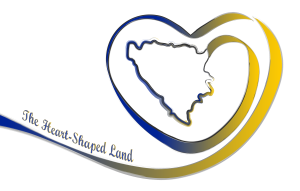We are Bosnian, we are Herzegovinian, we are Bosniac, Croat, Serb. We are the people of Bosnia and Herzegovina. Many different folk have lived across the lands that make up this country.
The traces and remains of human and animal activities date back to the Middle Palaeolithic age, the era of Neanderthal man. Remains left by Neanderthals include stone tools which are evidence of man’s presence in this area. The inhabitants of Bosnia and Herzegovina once lived in caves.
The first Homo Sapiens in this area appeared around 35,000 years ago, in the period of the Upper Palaeolithic. The remains left by first Homo Sapines are numerous. The most famous locality in Bosnia and Herzegovina from the Upper Palaeolithic period is the Badanj cave located near Stolac in Herzegovina. It was intensively inhabited between 12,000 and 14,000 years ago.
The Neolithic Period, also called the New Stone Age, was the final stage of cultural evolution or technological development among prehistoric humans. Neolithic people in Bosnia and Herzegovina, thanks to the prominence of mentals, used inventiveness and skill to gradually adopt a new way of economy, primarily in farming and livestock breeding. They lived in wooden dwellings, dugout shelters and pile dwellings. The most famous pile dwelling settlement is in Tuzla (Northeast part of Bosnia).
The Illyrians were the first residents of Bosnia and Herzegovina whose name and identity was known. They were great warriors, holders of advanced culture and the creators of a new social order that led to the creation of the first political organizations. They were divided into several tribes. Bosnia was settled by the most famous and most powerful Illyrian tribes: northwestern Bosnia was inhabited by Japodi, northern by Maezaei, eastern by Dindar, western by Dalmatians, middle Bosnia by Daesitiates, southern by Daorsi and Ardians. The most important part of Bosnian Illyrian history is the war which they led with the Romans for 150 years. A battle the Romans eventually won.
The Roman conquest of Bosnia significantly altered its ethnic picture. The arrival of the Romans started the process that transformed Bosnia into a multi-ethnic, multi-religious and multicultural country.
Despite this mix of cultures, during the Middle Ages lived a single Bosnian nationality called Bošnjani. Bosnia and Herzegovina had a population with the same name for more than 2000 years. In the Illyrian period in Bosnia lived a tribe called the Poseni (changed from Boseni), that name changed in the middle age to Bošnjani or Bosnians. The toponym corresponded to the ethnonym: Bassania country of Bassani/Boseni; in the Slavicization process the name Bosona was created, and then Bosnia, a nation of Bassani (Bosen) were created from the medieval Bošnjani.That term has developed to the contemporary form of Bosniaks, or Bosnian.
The moral characteristics and lifestyle of the medieval Bošnjana were closely related to their religion, which we call the Bogomil religion. The arrival of the Ottomans (1463) brought a transformation of lifestyle and religion and the Medieval Bosnian country was gone.
In the Ottoman period the authorities needed foreginers in the country as a work force. The cattlemen popuation from the neighboring countries (Serbia, Croatia and Montengero) setteled the area of Bosnia and Herzegovina. In the begging they lived mostly in the border areas, but eventually they began to live in all areas of the country.
Before the Austro-Hungarian arrival, Bosnia and Herzegovina had three national categories: Bosniac muslim, Bosniac catolic and Bosniac ortodox.
The establishment of the Austrian authorities in Bosnia and Herzegovina caused new migration movements and deployment of the population throughout the whole Bosnia and Herzegovina territory. And this time the changes were to the detriment of indigenous people, especially Muslims, but also Catholics and Orthodox because this migration finally wiped out the national category of Bosniac (Bosnians) Catholics and Bosniaks (Bosnians) Orthodox. The immigration started with Austrians, Croats, Czechs, Hungarian, Tirols. Germns, Serbs, etc.
Today we have three nationalities in Bosnia and Herzegovina. Untill the arrival of the Ottomans, lived single nationality, Bošnjani, existed in Bosnia and Herzegovina who largely belonged to the Bogomil faith, while a smaller part were Catholics and Orthodox. By different historical circumstances, the indigenous Bosnian – Orthodox population began to identify itself with the national immigrant Serb (Orthodox) and Bosnian Catholics with Croats (Catholics). The consequence of this process is that today we don’t distinguish the Bosnian catholic and settled Croats as well as Bosnian orthodyx and settled Serbs, Montenegrins.
